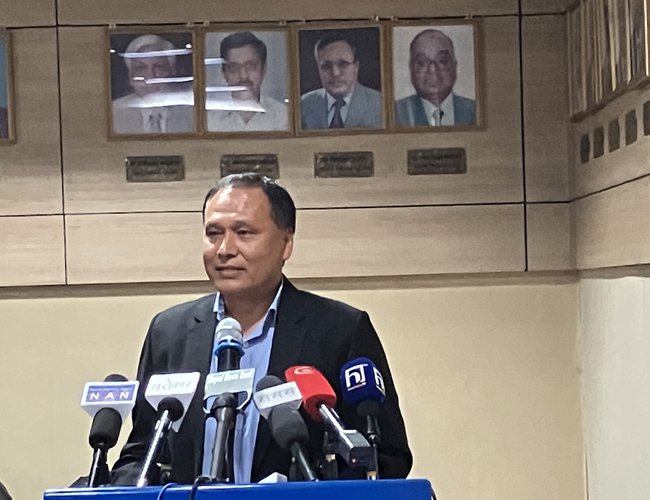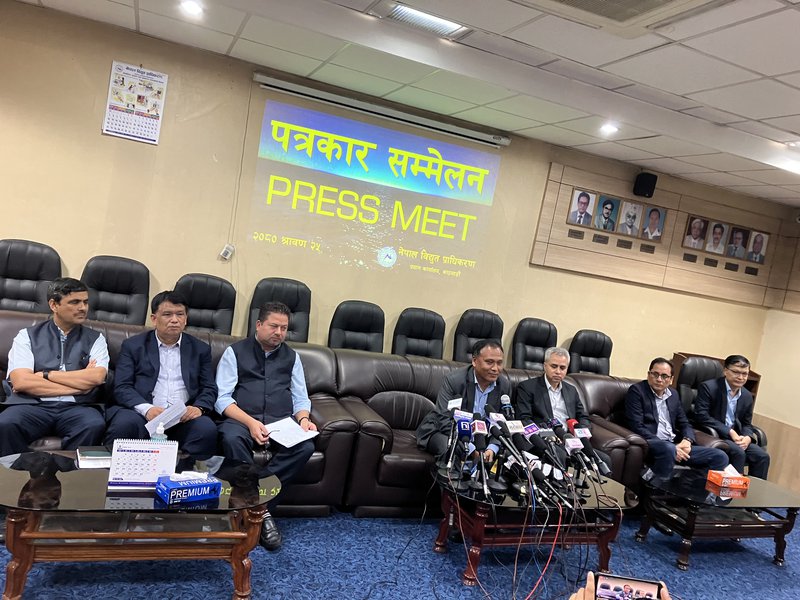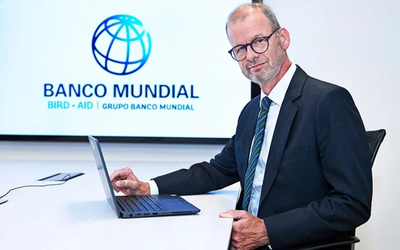
The Government of Nepal appointed me as the Managing Director of Nepal Electricity Authority (NEA) for a period of four years on August 10, 2021 through a decision of the Council of Ministers. Accepting the most difficult challenge of my personal life, I returned to NEA for a second term to fulfill the responsibility given to me by the Government of Nepal.
Improvement of NEA's financial condition, good governance within the organization, electrification to provide electricity to every citizen's home, expansion and strengthening of transmission and distribution infrastructure structures to make electricity supply reliable and dependable, promotion of large hydropower projects for production, increase in domestic consumption, export of surplus electricity, and other initiatives have increased.
Increase the profit of the organization and make it a strong, disciplined and respected organization in the country; increase electricity production and reduce leakage; expand access to maximum customers; reduce financial expenses; expand and improve transmission and distribution lines and substations; improve management; and provide customers with consistent, high-quality and reliable service. And we're working tirelessly to generate enough power. Electrification reached 95 percent two years ago, up from 89 percent.
The system's infrastructure structures have been improved and strengthened in response to consumer concerns about occasional power interruptions.
The development of 400 kV, 220 kV, and 132 kV transmission lines and substations has been phased, with the power consumption of 11 key cities in the country, including the federal capital, Kathmandu Valley, projected by 2050. Transmission and distribution substations are being automated as part of the Digital NEA program to modernize and automate service delivery.
Contracts for some long-stalled transmission and distribution projects were cancelled and new contracts were issued to accelerate project construction. Regular inspections and monitoring of unexpected sites were carried out to complete projects under construction.
Major Achievements During the Period
Financial and Administrative Reforms
The Authority's profit was 6.1 billion rupees in fiscal year 2077/78, but rose to 13.3 billion rupees in fiscal year 2078/79. According to the unaudited financial statement of the authority for the fiscal year 2079/80, the profit is 12.3 billion rupees. Last year, due to the prolonged dry season and reduced water flow in rivers and canals, power generation by the Authority and private sector hydropower plants decreased and electricity imports increased slightly to meet domestic demand, affecting profits.
The authority's revenue from energy sales and other sources was about Rs. 81 billion two years ago, but it is now over Rs. 1,018 billion. The Authority's profit has increased from Rs. 11 billion to Rs. 36.6 billion.
- The valuation of the Authority's real estate has been completed. In addition, the third financial restructuring of the Authority was planned and the process of issuing shares of the Authority to the public under the Authority Act 2041 was advanced.
- The performance management system was maintained as a standard for power leakage control, electricity tariff arrears collection, etc., based on the principle of "the right person in the right place" to improve customer service. - It was decided to establish a centralized payment and online payment system.
- For budget and expenditure control, the centralized payment and online payment system was made functional. The authority has invested about Rs. 48 billion in the last two years to expand and improve the transmission and distribution system. It has also accumulated about 30 billion rupees in the state fund from loans, interest and royalties.

Distribution and Customers
Electricity leakage has been reduced from 17.38 percent in 2077.78 to 13.46 percent at present. Distribution losses have been kept to a minimum of 9.76 percent.
About two years ago, 89 percent of the population received electricity through the national grid, but this figure has now risen to 95 percent. The provinces of Madhesh, Bagmati and Gandaki are essentially fully electrified. Koshi Province is 95 percent electrified, Lumbini Province is 98 percent electrified, Karnali Province is 67 percent electrified, and Sudurpaschim Province is 82 percent electrified.
Out of 753 local levels, 505 are almost fully electrified by the government system, 227 are electrified in most places and 21 are electrified by solar, micro and small hydro power. All preparations are being made to implement the government's announcement to electrify the entire country within the next two years.
Per capita energy consumption has increased from about 235 to 380 units. 800 MVA of industrial power load has been permitted in the last two years.
Due to a coordination problem with the relevant authorities, work on undergrounding the power distribution system of Kathmandu Valley, Bharatpur and Pokhara Metropolitan Area has started. Despite the delay, the work has been completed.
- Customers will receive a single phase connection in three days and a three phase meter in ten days as planned. The online application for three-phase connection has been set up. The smart meter connection program for three-phase users has been advanced.
- The NEA app was used to provide customers with a variety of information and services, including electricity tariff payment.
- 50 kV The availability of transformers for loads up to 100 kV remained unchanged.
- 200 kV for milking center, cold storage, community drinking water and community irrigation consumers. Assuming that electricity can be supplied through the Authority's transformers.
- Make a clear arrangement in relation to the charging station and for marketing, the electric line up to the location of the charging station. Electricity can be supplied through V. P. Co. transformers.
- The Authority has supported around 2.2 million customers for free energy, irrigation, drinking water, religious facilities, charging stations and other services.
- Approximately 40,000 meters were distributed free of charge to low-income households.
- Call centers have been established and are operational in all provinces to address customer complaints regarding energy supply.
- The installation of smart meters in Ratnapark and Maharajganjvitaran Kendra regions has been satisfactorily completed. The installation of smart meters throughout the country will be completed in the coming days.
Charging Stations and Street Lighting
1) Smart meter installation has been completed at Ratnapark and Maharajganj distribution centers. Installation of smart meters across the country will be completed in the coming days.
2) Architectural lighting has been designed and installed in Buddh, Swayambhu and Pashupatinath for temples, monasteries and other structures on the country's historical lists.
-3) To promote the use of electric vehicles and thereby increase electricity consumption, 51 charging stations have been constructed throughout the country and 13 more are under construction. Similarly, more than 100 charging stations have been installed in various parts of the country in line with the government's strategy to support the private sector.
Green Hydrogen Initiative
Under the Green Hydrogen Program, a feasibility study report on the production and use of green hydrogen in Nepal has been prepared with technical assistance from the Global Green Growth Institute (GGGI), Korea, and Kathmandu University, and is being implemented. As a model project, the authority plans to build a green hydrogen factory.
1) Architectural lighting has been designed and installed in Buddh, Swayambhu and Pashupatinath to illuminate temples, monasteries and other structures on the country's historical lists.
2) To promote the use of electric vehicles and thereby increase electricity consumption, 51 charging stations have been installed throughout the country and 13 more are under construction. Similarly, more than 100 charging stations have been installed throughout the country in line with the authority's strategy to support the private sector.
Transmission Line
Internal:
1) There are currently 5742 circuit kilometers of transmission lines and 8867 MVA capacity substations active.
2) 400/220/132 circuit kilometers in two years. The transmission line construction has been completed. When the circuit is 9300 kilometers long. Construction is in progress.
3) The construction of 17 substations with a total capacity of 10500 MVA has been completed. 54 capacity substations are under construction.
4) In order to meet the country's electricity demand by 2050, a master plan of transmission and substation structures has been developed by dividing major cities, including Kathmandu, into 11 clusters. As a result, construction will be completed gradually by pooling resources.
5,400/220/132 kV from the Hulaki Highway in the Madhesh region to meet the power needs of growing urbanization and industrialization. Construction of an east-west transmission line has started.
400 kV Butwal-Lamhi-Chinchu, Dododhara-Daichi (Attaria). The transmission line segment has been thoroughly studied and the construction phase has progressed steadily.
A comprehensive analysis of the transmission line crossing the Madhyapahari highway is underway. The 400 kV Arunhav-Tingla-Dudhkoshi-Dhalkebar and Arunhav-Inaruva-Anarmani transmission lines have been constructed and are under financial management. Extension of transmission lines, installation of capacitor bank and improvement and extension of distribution structure have been widely advanced for reliable and quality power supply.
International:
Construction of 400 kV Butwal-Gorakhpur transmission line has started.
Second 132 kV circuit Kushah-Kataiya. Second circuit 132 kV Parwanipur-Raxaul and double circuit 132 kV Mainhiya-Sampatiya. The construction of the transmission line has been completed.
400 kV Inaruwa-Purnia and Lamki-Wareli. Nepalgunj-Nanpar 132 KV line and Attiraya (Daichi)-Tanakpur 220 KV line. The transmission line construction process has progressed.
400 kV link between Ratmate and Rasuwagadi in China. The transmission line study has been completed.
Electricity Trade
Nepal started exporting 39 MW of electricity to India for the first time in November 2021 and now exports over 450 MW of electricity.
- The Ministry of Power in India is now reviewing another 600 MW of projects for export to India.
- 132 kV is connected to several areas in Vihar and Nepal. PTC will sell approximately 300 megawatts of power from India's central grid to the Vihar grid via transmission lines. India, the Bihar State Power Corporation and the Authority have entered into a tripartite agreement.
- A five-year medium-term power purchase agreement for 200 megawatts was signed with the Indian power trading company NVVN to supply power to the Indian state of Haryana. The agreement has been submitted to the Indian Ministry of Power for approval.
- India's NVVN is nearing completion of a three-way agreement with the Bangladesh Power Development Board to export power to Bangladesh.
Internal:
- So far, the total installed capacity of the system has reached 2822 MW, with hydro and solar projects totaling 1383 producing 751 MW and 632.37 MW respectively in 2078/79 and 2079/80 (up to the 24th of Shravan 2080/81).
- So far, about 8052 megawatts of power purchase and sale agreements have been signed, with only about 1774 megawatts negotiated in the last two years. In addition, the authority has already finalized a draft power purchase agreement for approximately 2290 megawatts. A total of 2168 megawatts of PPAs are currently being drafted.
- The base price for solar power is Rs. 5 and 94 paisa, and a procurement contract for about 100 megawatts of solar power is being auctioned for the first time.
Power generation
The final stage of raising funds for investment in the 1060 MW Upper Arun Hydropower Project has been completed. The construction of the office and staff quarters at the project site is nearing completion. Construction of approximately 24 kilometers of access roads, including 2 kilometers of tunnels, has begun. Selection of consultants for project construction supervision is nearing completion.
The Arun-4 Hydropower Project Authority and the Sutlej Jalvidyut Nigam, India, signed a Memorandum of Understanding for an installed capacity of 490 MW. To advance the project, the process of establishing a joint venture was advanced.
- Land acquisition and other preparatory activities are underway for the 210 MW Chainpur Seti project.
The final stage of development has been completed for four 270 MW hydropower projects under the supervision of Chilime Jalvidyut, a subsidiary of the authority.
The land acquisition process for the 635 MW Dudhkoshi Reservoir Hydropower Project has commenced and the essential investment process with the Asian Development Bank and other donors has been initiated.
Following the completion of financial management for the 99 MW Tamakoshi Fifth Hydropower Project, the procurement process to select contractors to commence construction has progressed.
-In addition, the construction procedure for the 60 MW Modi hydropower project has been invited and is well underway. The study for Sunkoshi 3 and several pumped storage projects such as Uttarganga and Andhikhola has started.
The authority will face more challenges in the coming days. The first is to institutionalize the gains made so far, while the second is to manage the market for the electricity generated. The third is to improve the reliability and quality of the electricity supply.
I further emphasize my determination to resolve the issues and focus all possible efforts in the coming days to provide adequate, regular, reliable and quality electricity to the people of the country and to establish a competent and profitable authority.
Nepal's Power Trade and Access to the International Power Market
In the last two years, the Nepal Electricity Authority has signed 1774 MW of power purchase and sale agreements. During this period, the Authority has made available an additional 1500 MW of PPAs for RoR hydropower projects. As a result, 1105 MW of PPAs have been approved and more are in the pipeline. Currently, there are 6750 MW targeted for RoR. And the 4500 MW gap towards RoR is being filled accordingly.
In the last two years, a total of 1246 MW of power generation capacity has been upgraded and connected to the national grid.
The Government of India has approved the export of 452 MW of power from 10 hydropower projects to India and the power is being exported in accordance with the terms of the agreement. The Authority has been exploring the power market for the past two years by soliciting bids to export and import power in India and reviewing bids from Indian generators and power trading organizations. While the bid did not immediately benefit the authority, the experience is expected to help Nepal in market design and expansion.
In addition to the power export projects approved by Nepal, the authority has signed an agreement with the Indian trading company NVVN. The capacity will be certified by the Government of India in the near future and preparations for export will continue. In total, the Nepal Electricity Authority has generated 1073 MW from 19 hydropower projects, including these. Two Indian power trading companies, PTC India and NVVN, have applied to the Government of India for power certification.
Nepal has decided to enter the Indian power market for the first time through a Memorandum of Understanding (MoU) with Bihar State Power Holding Company Limited (BSPHCL) and Nepal-Bihar 132 kV. The Indian power trading company PTC India and N.V. Pvt. They have entered into a power purchase and sale agreement.
Between New Butwal and Gorakhpur, NEA is constructing second 400 kV submarine transmission line. It is gaining international experience in infrastructure construction by forming a 50:50 joint ventures. The Power Grid Corporation of India is going to develop the Indian portion of the transmission structure, and construction of the line has commenced following the signing of an ITSA with the Power Grid.
The line is expected to be completed in approximately three years with an initial exportable capacity of approximately 2500 MW.
NEA will directly participate in the construction of two other 400 kV cross-border transmission lines, Inaruwa-Purnia and Dododhara-Bareli. According to the Indian side, the construction will be completed in 2027.28 and 2028.29. In ten years, the international transmission structure will be completed, enabling the export of about 10,000 MW of electricity to neighboring countries.
In the case of Bangladesh, 40-50 MW is likely to be exported. The Bangladesh Energy Export Authority, the Bangladesh Power Development Board, and the Indian power trading company NVVN have signed the tripartite power sales agreement, and the authority is preparing for Nepal's entry into the South Asian sub-regional market this year.
NEA has generated 25 MW of solar power and 62 MW of private sector power. The total solar power generated is 87 MW. When connected to the national grid, the maximum price per unit is Rs. 5.94. The final stage of bid evaluation for procurement of 90 MW of solar power through PPP has started.
The Tanakpur substation in India is connected to a power line with a capacity of 50 MVA and a voltage range of 220-132 kV. The capacity of the power transformer has been increased to 100 MVA at the cost of the authority, allowing the authority to import/export more power.
Kataiya-Kushaha and Raxaul-Parwanipur 132 kV transmission lines connect to India. The addition of a second circuit to the transmission lines has increased power reliability and transmission capacity.
Through Nepal-India discussions, the Nepal Electricity Authority has proposed additional transmission lines to connect with Uttar Pradesh and Uttarakhand in India, and studies and construction have been completed in this regard.
The Mainhia-New Nautanuwa and Kohalpur-Nanpara 132 kV transmission lines connecting Nepal and Uttar Pradesh are nearing completion. This paves the way for Nepal to export electricity to Uttar Pradesh during the rainy season.
The capacity of the Tanakpur-Mahendranagar transmission line is 132 kV. With the completion of future hydropower projects in the Far West region, the capacity of the line will be increased to 220 kV. At the request of the Nepal Electricity Authority, preparations are being made to begin studies on the construction of a new line between Nepal and India at this voltage level.
Kul Man Ghising is the Managing Director of the Nepal Electricity Authority. This is an excerpt from his remarks at a press conference on August 10 to mark the end of his two-year tenure as Managing Director.
- MELAMCHI WATER SUPPLY: No Interruption During Monsoon
- Jun 25, 2025
- KOREAN RETURNEES: Successful Integration
- Jun 25, 2025
- UPPER TRISHULI-1: Engaging With Local
- Jun 25, 2025
- IME GROUP: Twenty Five Years Of Journey
- Jun 24, 2025
- NEPAL’S AIR POLLUTION: A Growing Health Concern
- Jun 24, 2025















